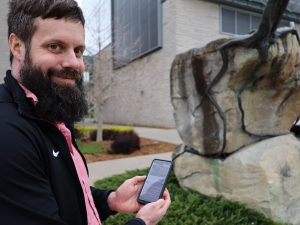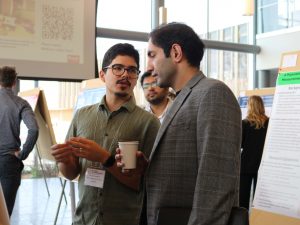
Brock professor Hans Skott-Myhre displays the cover image for the soon-to-be-released book Habitus of the Hood, which he co-edited with one of his former students
A Brock professor and the master’s student he supervised have co-edited an eagerly anticipated book that gives us new perspectives of the ’hood.
Habitus of the Hood is a collection of essays that explores how the ‘hood has been conceived — from the experiences of residents, particularly its youth, to its representation in popular culture.
Hans Skott-Myhre is an associate professor of Child and Youth Studies. He’s on faculty in the MA in Popular Culture and the Interdisciplinary PhD program. He’s also an adjunct professor in Child and Youth Studies at the University of Victoria.
Chris Richardson, the other editor, received his MA in Popular Culture in 2008 from Brock. He’s currently a PhD candidate in the Faculty of Information and Media Studies at the University of Western Ontario.
The book, three years in the making, contains a mix of contributions from scholars who’ve lived inside, outside or both sides of the ’hood. The book’s published by Intellect Ltd. and is scheduled for release in October.
“I was extremely pleased that Chris asked me to co-edit his first book,” said Skott-Myhre. “His vision for an alternative reading for the ’hood was powerful and compelling. It has been an honour to be able to advise, co-author and learn from him.”
Habitus is a complex concept that describes the set of socially learned skills and ways of acting as individuals, groups, societies and nations that are acquired through everyday experiences and activities.
The book explores the way that history, society and geography interact with the identity formation of young people, Skott-Myhre said. Habits, beliefs and practices of the people who live in the space also shape the space, often contrary to media expectations and portrayals.
“The ’hoods are a place where people live, work, go to the grocery store,” Skott-Myhre said. “The dominant media and agenda of the ruling class often try to explain away the suffering that make the ‘hoods seem scary — broken families, fatherless homes, high crime, poverty. In fact, there is a rich and supportive community where alternative economies and cultures exist and thrive.”
His chapter in Habitus of the Hood was based on living in the ’hood in the U.S. Before entering academe, he worked for 25 years with homeless and runaway kids.
“I left that work with an appreciation for the value of struggle and revolution,” he said. “People who won’t be assimilated into the system find another way, and it’s not through government or NGOs or the middle class.”
Richardson became interested in perspectives of the ’hood after growing up in Scarborough. Even though did not grow up in the ’hood, he often felt that the entire city of Scarborough was painted with the same brush, stereotyped as an area of high crime. There was little attempt to scratch beyond that thin veneer to discover its rich and diverse aspects. The areas of Jane-Finch and Regent Park were similarly stamped as areas of high crime and disintegrating family structures.
“The ‘hood is a place we all think we know,” said Richardson. “It’s on TV. It’s on film. It’s in music. But for those who live it day to day, it’s a very different place.”
Richardson credits Brock with encouraging him to pursue his interests in researching the ’hood.
“My experiences at Brock really opened my eyes to what was possible in academe,” he said. “When I wanted to investigate and write about Tupac, hip hop, gangster films, or Sesame Street, the faculty encouraged me to pursue those ideas and showed me how to do so in a rigorous, scholarly way.
“When Hans and I began talking about doing a book, I thought there was no way he would see it through,” he said. “He’s a very busy professor and I was a lowly MA student. But he said yes right away and he’s been engaged and encouraging throughout the process.”









